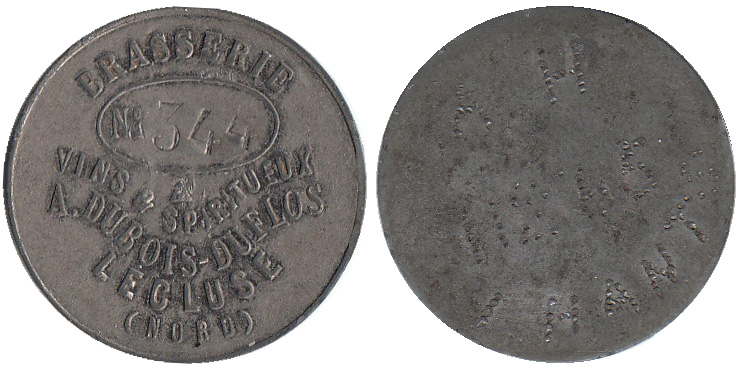Jetons à consommer – Lecluse (Nord) – Brasserie Dubois-Duflos
 Suivre cette page
Suivre cette pageLa brasserie exploitait plusieurs débits de boisson dans lesquels devaient être placés les machines à sous.
Détruite pendant la 1ère guerre mondiale, la brasserie a rouvert en 1923 mais sous un autre nom.
Le jeton présenté en laiton nickelé a une particularité : l’avers a été entièrement effacé par usure mécanique, et on y a gravé en pointillé sur 3 lignes : AH / H265 / I HANTS. Comme ce jeton a été trouvé au Royaume-Uni, on peut penser qu’il s’agit d’un matricule de soldat d’un régiment du Hampshire ? Un visiteur d’Outre-Manche pourrait-il nous donner son avis ?
 Ajouter à ma collection
Ajouter à ma collection Vendre/échanger
Vendre/échanger  Rechercher
RechercherValeur : 10 centimes (10 c)
Période : vers 1910-1914
Matière : Laiton
Forme : Rond festonné
Diamètre (mm) : 30,0
 Ajouter à ma collection
Ajouter à ma collection Vendre/échanger
Vendre/échanger  Rechercher
RechercherValeur : 10 centimes (10 c)
Période : vers 1910-1914
Matière : Laiton nickelé
Forme : Rond
Diamètre (mm) : 30,0



The three main element to these pieces are:
1. Name or initials {AH = Arthur Hill}
2. Name of regiment {I HANTS = First Hampshire Regiment; indeed, it looks as if there may only be one}
3. Regimental number {11265}
With only initials rather than name, reading of the regimental number is vital, after which you have to try and find reference to it in some records or other. If the number is faint and you don’t get anywhere, then you just have to look again, see if there are any alternative interpretations of it, and repeat the process. The regimental numbers are usually about four, five or six digits long, occasionally less. Each regiment numbers independently and has their own series, so if you can identify the regiment that just helps refine your search.
HANTS is short for Hampshire, one of our English counties, the equivalent of your départments. The fact that a soldier joined a Hampshire-based regiment does not, however, indicate that he lived in or near Hampshire, although it does increase the probability.
I was fortunate to find the soldier’s identity fairly quickly, and records of two awards made to him, for which see the attached. However, I could not find him on the databases for either service records or pensions, which is a pity, because that would probably have given us information like his date of birth or home address, which would have been very useful for ongoing research such as trying to find him on the national census. I guess that those records were probably amongst those destroyed in WW2, although it is possible that they have just not been loaded on the databases as yet.
I get the impression that Arthur Hill probably remained a private for the whole war, and survived it. I have not found him in the WW1 death records.
Where regiments still exist it is sometimes possible to write to their headquarters and ask for information in return for a small donation, but I have only done it once, quite a few years ago. The Forces War Records database may be a modern online accumulation of such data; I am not familiar with it, but 11265 Arthur Hill is on it {see below}. As it is not one of the genealogical facilities to which I subscribe, however, I do not have sight of the detailed entry.
Best wishes,
David
https://wikicollection.fr/wp-content/uploads/2020/11/forces.jpg
A part of this Regiment was sent to north of France in august 1914 ; the token has probably been find and engraved in France (to replace a lost official plate ?), and recently found again in Sussex/limit Hampshire.
Best regards, JC.